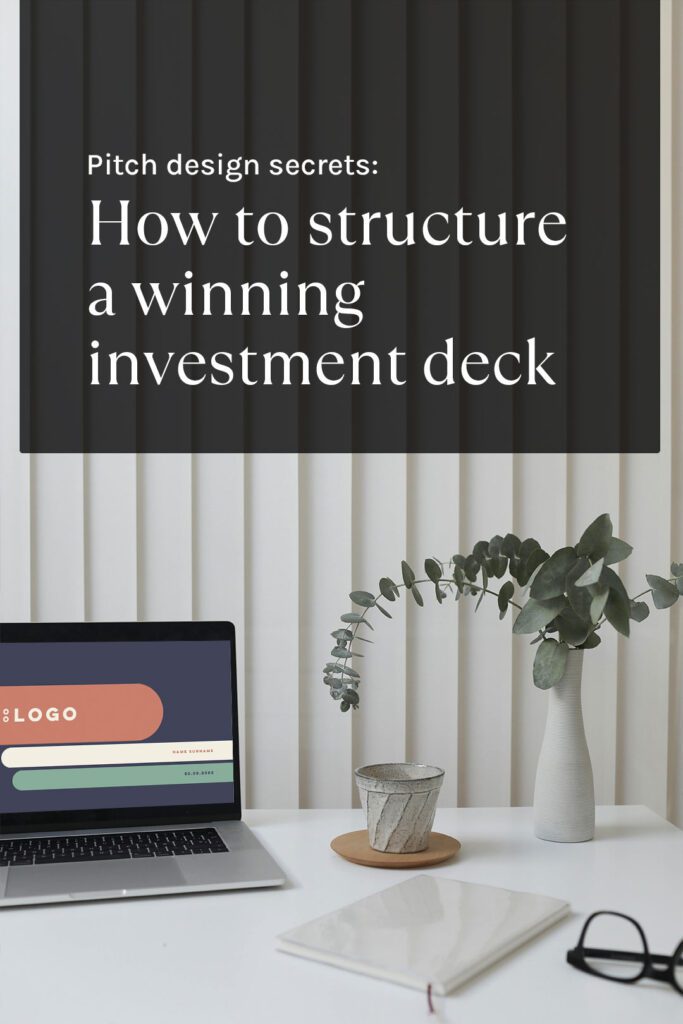May 2, 2024
Pitch design is not just the design of a presentation. It encapsulates your pitch deck’s design and structure to help investors understand your business and get on board with your vision.
After all, your pitch deck is more than slides with words; it’s the face of your dream, team, strategy, and potential. This guide is about how to nail your pitch design, ensuring it speaks directly to investors and answers their questions. It’s the secret to making a lasting impression.
Understanding the basics of pitch design
Pitch design is about more than making things look pretty. It’s about clarity, engagement, and making an impact. A well-designed investment pitch deck helps communicate your vision and value proposition more effectively, making it easier for investors to see the potential in your startup.
It’s your first (and sometimes only) chance to capture an investor’s interest and convince them that your venture is worth their investment.
Table of Content:
- Understanding the basics of pitch design
- Pitch design: Components of a successful investment deck
- What makes a deck stand out?
- Common pitfalls to avoid
- Finalizing your pitch deck: The Do’s and Don’ts
- The most important slides in your pitch deck
- How I can help with your pitch design
- Final Pitch deck design secrets
- Final review tips
Pitch design: Components of a successful investment deck
1. Cover slide
A clean, attention-grabbing cover sets the tone for the entire presentation. Your pitch design starts here, making your startup memorable from the first slide. Make sure it grabs attention while keeping to the general brand guidelines of what to include:
- Title of deck
- Logo
- Tagline or value proposition that clearly states what you do.
Bonus tips: Remember to use your brand colours consistently throughout the presentation. To tailor your cover slide to ensure it’s more personal to the investor you’re targeting, you can also add the potential investor’s logo/name to the cover.
2. Mission Statement
This slide can outline your company’s mission, a.k.a your purpose. It should state what your company is doing and how it helps your target audience, outlining the problem you solve and your unique selling proposition (USP) – i.e., what you do differently. The purpose slide is the one-sentence elevator pitch or overview of the entire presentation. It should hook your audience immediately, defining your key message and purpose.
3. The Problem Statement: Describe the problem
Use your pitch design to highlight the problem you’re solving – and its urgency. This slide should resonate with investors by showing that you understand your customer. Visuals will help you illustrate the pain points your potential customers are experiencing more vividly, making the problem (and your solution) more relatable. If your problem statement slide explains the problem you’re about to solve, you’re already starting to stand out and capture the interest of the investors you’re talking to.
4. Your Solution slide: Present your solution
This slide will show how your product or service solves the problem you identified in the previous slide so make sure you put time into the design of your solution slide. Highlight the benefits of your product or service and why it’s superior to existing solutions. Use images, icons, or a diagram to demonstrate how your product or service works. A good pitch design makes your solution understandable at a glance.
5. Product or service showcase
Present your product or service in greater detail. Outline what it is, describe how it works/what it does, and provide examples or screenshots of the process.
6. Why now?
This slide is all about why an investor should invest now. What are the driving forces in the market that make your solution relevant at this moment? What has changed or ensured this is the perfect time for your product or service to succeed? Why is the window of opportunity open right now? This slide presents a sense of urgency and should lead into the market opportunity slide.
7. Market Opportunity – Showcase the market potential
This slide is where you can define your target market and the size of the opportunity. You can use great photography to represent what your target market looks like or use avatars or sketches that will capture your understanding of your audience. Charts and graphs are your friends, making it easier to display data that backs up your claims about the market’s potential for growth and how your company will capture a share of it.
Make sure you know the total addressable market and explain it clearly. A well-designed analysis can make complex data easy to grasp, showing investors the size of the opportunity in an instant.
8. Competitor Analysis
Your competitor analysis is your chance to show that you’ve researched and understand the competition you’ll face in the market. Acknowledge any competitors and explain how your solution is different and better. A key competitor matrix can be helpful to show competitors in your field. Highlight your competitive edge and what makes your startup stand out. If you don’t have any direct competitors in this space, use this slide to display how your product or service is the first of its kind.
9. Traction and milestones
This slide allows you to display any traction your business has experienced, whether it’s milestones passed or awards you’ve achieved. Use this slide to highlight any positive trajectory or progression. It can include:
- Sales numbers
- Website traffic
- App downloads
- Growth metrics
- Strategic partnerships
- Press and accolades
- Testimonials
10. Business Model – Present the financials
Take the opportunity to simplify your business model on this slide, using clean, straightforward visuals to explain how your company brings in revenue – or plans to. You can use icons and brief captions. Detail your pricing model, revenue streams, budget, and any key financial details or opportunities to scale that will interest investors.
Even though this topic might be a little less interesting compared to other slides, you can use this slide to demonstrate your ability to provide a concise business overview to entice the financial and creative minds in the room.
11. Financial Projections
Share a financial forecast for the next 3-5 years in the financial projections slide. Well-designed financial slides make your projections more convincing and memorable. You can use an infographic to display numbers more visually or present a simplified financial forecast to map your potential growth. Remember to include your projected revenue, costs, and profitability.
This slide should present the company’s current financial situation and the “burn” rate (monthly or yearly cash loss while developing and marketing its product). Be realistic and prepared to justify your assumptions.
12. Go-to-Market Strategy
Your strategy for going to market is your chance to demonstrate how you will reach your target customers. This slide includes your marketing and sales strategies and any partnerships you will leverage. You can use graphics and flowcharts to detail your go-to-market plan more dynamically.
Include key marketing channels you plan to use (paid search, social media, TV, radio, email marketing) and what’s worked in the past. You can also include customer acquisition costs per customer (and projected value of each customer).
Good pitch design will ensure this slide presents these figures dynamically, turning your go-to-market strategy into an exciting roadmap to success.
13. The Team: Highlight the people who can execute your vision
Investors invest in people. Highlight your team’s expertise, experience, and roles to build confidence in your ability to execute your business plan. Using professional team photos and relevant bios with a consistent design theme can make your team’s skills and passion jump off the page, building trust with investors and making them want to be part of this journey.
TIP: If you truly have a strong team, with decades of knowledge and experience behind them, it can add value to move this slide after the mission statement to add additional interest early on.
14. The Ask: End with a clear call to action
A clean, bold design can make your funding request stand out. Clearly describe how much you’re hoping to raise, what you will use the funds for, and what’s in it for the investors. You can also include how long any financing will last (15-18 months) and any milestones you’ll reach with this financing.
Using great pitch design can highlight the investment opportunity and what you want from potential backers.
Pitch deck design for maximum impact
Remember that every slide of your pitch deck offers a chance to tell your story. Consistency in design keeps your presentation professional, while creative visuals keep your audience engaged. Use high-quality graphics and consistent branding, and avoid clutter. Each slide should convey one idea clearly and concisely. Remember, your deck is a tool to facilitate your presentation, not replace it.
What makes a deck stand out:
Your ability to tell a story can significantly impact your pitch. Design your pitch deck to weave your data, images and text into a narrative connecting the problem, solution, and market opportunity. Highlight any traction you’ve gained, such as customer testimonials or milestones, to demonstrate proof of concept and market demand.
Less is more in good pitch deck design: aim for simplicity, clarity, and impact. If you have less to say, use fewer slides. And don’t get lost in the details or the order of your slides as long as you’re logically telling your company’s story.
By using unique visuals, consistent branding, and a clear storyline, you can take your pitch from run-of-the-mill to remarkable.

Be sure to read this blog: How to write converting slide titles
Common pitfalls to avoid
Don’t let poor pitch design distract investors from your message. Avoid overwhelming your audience with too much text or overly complex financials. Avoid cluttered layouts, inconsistent styles, and overuse of visual elements that might make your pitch look like it’s more style than substance. Your pitch design should enhance your story, not overshadow it.
Remember that you must back up your projections, so they should be ambitious and grounded. Be ready to explain or qualify any assumptions you’ve made.
Misjudging your competition can also be a critical error. Understand your market and where you fit within it.
Finalizing your pitch deck
Great pitch design helps your pitch, making your entire presentation more persuasive. But all your efforts in making it look good are nothing without delivery. Present your deck to your coach, mentors, or peers to get additional insights – and be ready to adjust and tweak the content or design based on their feedback. Practice your pitch to ensure your delivery is as strong as your deck.
Do:
- Keep it simple and focused (with only one idea per slide!)
- Use data and visuals to support your story.
- Make sure your story and structure flows logically.
- Show passion and knowledge about your market.
- Practice so that you are comfortable with online/video tools so that your presentation is smooth and professional.
- Be prepared to answer follow-up questions.
Don’t:
- Overload slides with information.
- Make typos or spelling or grammar mistakes.
- Use inconsistent fonts.
- Ignore or undervalue your competition.
- Complicate your offerings so it’s difficult for anyone to understand what you do.
- Forget to state your funding ask and its purpose clearly.
The most important slides in your pitch deck
What happens if you want to send a short introductory pitch deck to introduce your company and hopefully, entice the investor (and potential partners) into meeting with you? An introduction slide is usually 10 slides long, providing only enough detail to capture an investor’s interest. So, what’s important to keep in your pitch design and what can you leave out?
The following table shows you what slides are must-have and what slides are less important given the purpose of your deck.
| Name of Slide | Introduction deck | Investment deck | Client deck |
| 1. Cover slide | Y | Y | Y |
| 2. Mission statement | Y | Y | Y |
| 3. Problem slide | Y | Y | Y |
| 4. Solution slide | Y | Y | Y |
| 5. Product or service showcase | – | Y | Y |
| 6. Why now? | – | Y | Y |
| 7. Market potential | Y | Y | Y |
| 8. Competitor analysis | – | Y | Y |
| 9. Traction and milestones | Y | Y | Y |
| 10. Business model | Y | Y | Y |
| 11. Financial projections | Y | Y | Y |
| 12. Go-to-market strategy | Y | Y | Y |
| 13. The team | – | Y | Y |
| 14. Your ask | Y | Y | Y |
Remember that your introduction deck has to stand alone, providing enough detail on your company without providing too much information. It is designed to be read without someone speaking. This deck is often emailed to potential investors.
The investment deck is what you present either in-person or via online meeting tools like Zoom, and the bulk of the communication should be communicated orally. This deck is more visual, with a limited amount of words and numbers.
Last but not least, the client deck will be designed in a similar way to the investment deck, but must be tailored to clients who would be interested in distributing or buying your product or service, and presenting a clear and compelling answer to the question: “what’s in it for them?”
How I can help with your pitch design
Your investment pitch deck must blend great pitch design, storytelling and strategic insight compellingly and logically. Your time and investment into your pitch deck gives investors the impression that you take pride in your idea, and that you want to set yourself apart from other startups. A well-crafted pitch design and deck allows you to make a good first impression, much like going to a job interview well-prepared and wearing your best suit.
My pitch deck design services help startups develop structured, engaging and professional pitch decks to persuade investors that your company is worth the risk. While not a full-service pitch deck design agency, I can also provide pitch deck and outsourced copywriting services to help you tell your story or improve your message and impact.
Explore my portfolio to see how I can elevate your pitch design for a winning investment pitch deck.
Final pitch design secrets:
Your investment pitch deck is a crucial tool in your fundraising toolkit. It’s your opportunity to make a compelling case for your startup, highlighting your innovation, what your team plans to do with it, and the potential return on investment. Remember, investors are looking for reasons to believe in your success. Make sure your pitch design and story provide investors with reason to believe in you and your team as much as you do.
Final review tips:
It’s easy to get lost in the detail. Go back and see if your deck answers the following questions:
- Does your pitch deck tell your company’s story?
- Can investors make money with this business? How will your company grow enough to make this happen?
- Can you read or present this deck in under 5 minutes?

I'm Marike
I provide professional presentation design services specializing in PowerPoint, Keynote and Google Slides.
Follow me on social:
Buy US a coffee
Enjoying the content?
Show your appreciation...
July slots are limited, are you ready to get started?
Rush project slots may be available.
YOUR Message*
YOUR NAME*
YOUR Email Address*
how did you find me?
where are you based?*
I'm ready! let's start
By clicking the submit form button you agree to my Privacy Policy.
Mail me directly at:
info @ marikedesigns dot com
